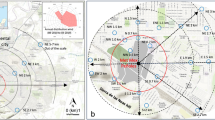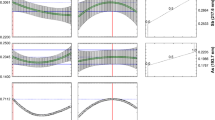Abstract
Research has shown the presence of high levels of arsenic (up to 2666 mg As kg−1) in tailings from a gold mining area of Brazil. This is an important point of attention, generating concerns about impacts on human health. Yet, a recent study showed that As bioaccessibility in the same area was very low (<4.4 %). Thus, determination of the direct solid-phase speciation of As in the mine tailings and windblown dust is needed to explain this low bioaccessibility. Mine samples were collected from four subareas and windblown dust from eight sites. Synchrotron-based bulk-X-ray absorption near-edge structure (bulk-XANES) spectroscopy, micro-X-ray absorption near-edge structure (μ-XANES), and μ-X-ray fluorescence (μ-SXRF) spectroscopy were applied to determine As speciation. Bulk-XANES spectra indicated that As occurs as the As(V) oxidation state. Micro-XANES and μ-SXRF analyses revealed that As was also present as arsenopyrite (FeAsS) and its weathering products, but mostly it was As(V) as poorly crystalline ferric arsenate. This supports the findings of low bioaccessible As and highlights the importance of Fe oxides in immobilizing As in the terrestrial environment. All air particulate samples exhibited As-rich particles (up to 313 mg As kg−1). The air particulates exhibited solid-phase As species very similar to those found in the mine samples, which indicates that As in the windblown dust is not easily available.




Similar content being viewed by others
References
Andrade RP, Santana-Filho S, Mello JWV, Figueiredo BR, Dussin TM (2008) Arsenic mobilization from sulfidic materials from gold mines in Minas Gerais state. Quim Nov. 31:1127–1130
Borba RP, Figueiredo BR, Matschullat J (2003) Geochemical distribution of arsenic in waters, sediments and weathered gold mineralized rocks from Iron Quadrangle, Brazil. Environ Geol 44:39–52
Bowell RJ (1994) Sorption of arsenic by iron oxides and oxyhydroxides in soils. Appl Geochem 9:279–286
Bundschuh J, Litter MI, Parvez F, Román-Ross G, Nicolli HB, Jean J-S et al (2012) One century of arsenic exposure in Latin America: a review of history and occurrence from 14 countries. Sci Total Environ 429:2–35
Cebrian ME, Albores A, Garcia-Vargas G, Del Razo LM (1994) Chronic arsenic poisoning in humans: the case of Mexico. In: Nriagu JO (ed) Arsenic in the environment part 1: cycling and characterization pp 93–107
Chen N, Jiang DT, Cutler J, Kotzer T, Jia YF, Demopoulos GP, Rowson JW (2009) Structural characterization of poorly-crystalline scorodite, iron(III)–arsenate co-precipitates and uranium mill neutralized raffinate solids using X-ray absorption fine structure spectroscopy. Geochim Cosmochim Acta 73:3260–3276. doi:10.1016/j.gca.2009.02.019
Choe E, Kim K-W, Bang S, Yoon I-H, Lee K-Y (2009) Qualitative analysis and mapping of heavy metals in an abandoned Au–Ag mine area using NIR spectroscopy. Environ Geol 58:477–482. doi:10.1007/s00254-008-1520-9
Conama (1990) Air quality standards. Resolution No33/1990, National Council for the Environment, Available at: http://portal.saude.gov.br/portal/arquivos/pdf/conama_03_90_padroes_de_qualidade_do_ar.pdf (in Portuguese)
Conama (2009) Soil quality guideline values for the presence of chemical substances. Resolution No420/2009, National Council for the Environment, Available at: http://www.mma.gov.br/port/conama/legiabre.cfm?codlegi=620 (in Portuguese)
Craw D, Falconer D, Youngson JH (2003) Environmental arsenopyrite stability and dissolution: theory, experiment, and field observations. Chem Geol 199:71–82. doi:10.1016/S0009-2541(03)00117-7
Davis A, Ruby MV, Bloom M, Schoof R, Freeman G, Bergstrom PD (1996) Mineralogic constraints on the bioavailability of arsenic in smelter-impacted soils. Environ Sci Techol 30:392–399. doi:10.1021/es9407857
Deschamps E, Ciminelli VST, Lange FT, Matschullat J, Raue B, Schmidt H (2002) Soil and sediment geochemistry of the Iron Quadrangle, Brazil: the case of arsenic. J Soils Sediments 2:216–222. doi:10.1007/BF02991043
Dove PM, Rimstidt JD (1985) The solubility and stability of scorodite FeAsO4.2H2O. Am Mineral 70:838–844
Drahota P, Filippi M (2009) Secondary arsenic minerals in the environment: a review. Environ Int 35:1243–1255. doi:10.1016/j.envint.2009.07.004
Fendorf S, Eick MJ, Grossl P, Sparks DL (1997) Arsenate and chromate retention mechanisms on goethite. 1. Surface structure. Environ Sci Technol 31:315–320. doi:10.1021/es950653t
Filippi M, Goliáš V, Pertold Z (2004) Arsenic in contaminated soils and anthropogenic deposits at the Mokrsko, Roudný, and Kašperské Hory gold deposits, Bohemian Massif (CZ). Environ Geol 45:716–730. doi:10.1007/s00254-003-0929-4
Filippi M, Doušová B, Machovič V (2007) Mineralogical speciation of arsenic in soils above the Mokrsko-west gold deposit, Czech Republic. Geoderma 139:154–170. doi:10.1016/j.geoderma.2007.01.015
Foster AL, Brown GE Jr, Tingle TN, Parks GA (1998) Quantitative arsenic speciation in mine tailings using X-ray absorption spectroscopy. Am Mineral 83:553–568
Grossl PR, Eick M, Sparks DL, Goldberg S, Ainsworth CC (1997) Arsenate and chromate retention mechanisms on goethite. 2. Kinetic evaluation using a pressure-jump relaxation technique. Environ Sci Technol 31:321–326
Hrudey SE, Chen W, Rousseaux CG (1996) Bioavailability in environmental risk assessment. Lewis Publishers, Boca Raton, FL
Jia Y, Xu L, Fang Z, Demopoulos GP (2006) Observation of surface precipitation of arsenate on ferrihydrite. Environ Sci Technol 40:3248–3253
Krause E, Ettel VA (1989) Solubilities and stabilities of ferric arsenate compounds. Hydrometallurgy 22:311–337
Kreidie N, Armiento G, Cibin G, Cinque G, Crovato C, Nardi E, Pacifico R, Cremisini C, Mottana A (2011) An integrated geochemical and mineralogical approach for the evaluation of arsenic mobility in mining soils. J Soils Sediments 11:37–52. doi:10.1007/s11368-010-0274-7
Kuo S (1996) Phosphorus. In: Sparks DL (ed) Methods of soil analysis. SSSA, Madison, pp 869–920
Lee J-S, Lee S-W, Chon H-T, Kim K-W (2008) Evaluation of human exposure to arsenic due to rice ingestion in the vicinity of abandoned Myungbong Au–Ag mine site, Korea. J Geochem Explor 96:231–235. doi:10.1016/j.gexplo.2007.04.009
Lengke MF, Sanpawanitchakit C, Tempel RN (2009) The oxidation and dissolution of arsenic-bearing sulfides. Can Mineral 47:593–613. doi:10.3749/canmin.47.3.593
Mandal BK, Suzuki KT (2002) Arsenic round the world: a review. Talanta 58:201–235
Matschullat J, Perobelli R, Deschamps E, Figueiredo BR, Gabrio T, Schwenk M (2000) Human and environmental contamination in the Iron Quadrangle, Brazil. Appl Geochem 15:181–190
Mello JWV, Roy WR, Talbott JL, Stucki JW (2006) Mineralogy and arsenic mobility in arsenic-rich brazilian soils and sediments. J Soils Sediments 6:9–19. doi:10.1065/jss2005.09.144
Meunier L, Walker SR, Wragg J, Parsons MB, Koch I, Jamieson HE, Reimer KJ (2010) Effects of soil composition and mineralogy on the bioaccessibility of arsenic from tailings and soil in gold mine districts of Nova Scotia. Environ Sci Technol 44:2667–2674. doi:10.1021/es9035682
Morin G, Calas G (2006) Arsenic in soils, mine tailings, and former industrial sites. Elem 2:97–101. doi:10.2113/gselements.2.2.97
Murciego A, Alvarez-Ayuso E, Pellitero E, Rodríguez M, García-Sánchez A, Tamayo A, Rubio J, Rubio F, Rubin J (2011) Study of arsenopyrite weathering products in mine wastes from abandoned tungsten and tin exploitations. J Hazard Mater 186:590–601. doi:10.1016/j.jhazmat.2010.11.033
Nelson DW, Sommers LE (1996) Total carbon, organic carbon and organic matter. In: Sparks DL (ed) Methods of soil analysis: Chemical methods, Part 3. SSSA, Madison,WI, pp 961–1010
Ono FB, Guilherme LRG, Penido ES, Carvalho GS, Hale B, Toujaguez R, Bundschuh J (2012a) Arsenic bioaccessibility in a gold mining area: a health risk assessment for children. Environ Geochem Health 34:457–465. doi:10.1007/s10653-011-9444-9
Ono FB, Guilherme LRG, Mendes LA, Carvalho GS (2012b) Replication of an IVG protocol to estimate bioaccessible arsenic in materials from a gold mining area in Brazil. Rev Bras Ci Solo 36:1355–1360
Paktunc D, Foster A, Laflamme G (2003) Speciation and characterization of arsenic in Ketza River mine tailings using X-ray absorption spectroscopy. Environ Sci Technol 37:2067–2074
Ravel B, Newville M (2005) ATHENA, ARTEMIS, HEPHAESTUS: data analysis for X-ray absorption spectroscopy using IFEFFIT. J Synchrotron Radiat 12:537–541
Ruby MV, Schoof R, Brattin W, Goldade M, Post G, Harnois M, Mosby DE, Casteel SW, Berti W, Carpenter M, Edwards D, Cragin DW, Chappell W (1999) Advances in evaluating the oral bioavailability of inorganics in soil for use in human health risk assessment. Environ Sci Technol 33:3697–3705
Smedley PL, Kinniburgh DG (2002) A review of the source, behaviour and distribution of arsenic in natural waters. Appl Geochem 17:517–568
Smith E, Naidu R, Alston AM (1998) Arsenic in the soil environment: a review. Adv Agron 64:149–195
Toujaguez R, Ono FB, Martins V, Cabrera PP, Blanco AV, Bundschuh J, Guilherme LRG (2013) Arsenic bioaccessibility in gold mine tailings of Delita, Cuba. J Hazard Mater 262:1004–1013. doi:10.1016/j.jhazmat.2013.01.045
Walker SR, Jamieson HE, Lanzirotti A, Andrade CF, Hall GEM (2005) The speciation of arsenic in iron oxides in mine wastes from the Giant gold mine, N.W.T.: appication of synchrotron micro-XRD and micro-XANES at the grain scale. Can Mineral 43:1205–1224
Wang S, Mulligan CN (2006) Occurrence of arsenic contamination in Canada: sources, behavior and distribution. Sci Total Environ 366:701–721
Wang S, Wang P, Men B, Lin C, He M (2012) Chemical forms and ecological risk of arsenic in the sediment of the Daliao River System in China. Environ Monit Assess 184:2237–2245. doi:10.1007/s10661-011-2113-8
Wenzel WW, Kirchbaumer N, Prohaska T, Stingeder G, Lombi E, Adriano DC (2001) Arsenic fractionation in soils using an improved sequential extraction procedure. Anal Chim Acta 436:309–323
Who (1999) Arsenic in drinking water. Fact sheet No. 210. World Health Organization, Geneva Available at: http://www.who.int/topics/arsenic/en/
Acknowledgments
We gratefully acknowledge funding received from CNPq, CAPES, and FAPEMIG, Brazil. We acknowledge the Brazilian Synchrotron Light Laboratory-LNLS technical, scientific, and administrative staff for assisting with the bulk-XAS analysis (project 11781, supported by LNLS/ABTLuS/MCT). Use of the National Synchrotron Light Source (NSLS), Brookhaven National Laboratory, was supported by the U.S. Department of Energy, Office of Science, Office of Basic Energy Sciences. Beamline X27A at NSLS is supported in part by the U.S. Department of Energy—Geosciences (DE-FG02-92ER14244 to The University of Chicago—CARS). We would like to thank the Delaware Environmental Institute (DENIN) and Environmental Soil Chemistry research group of the University of Delaware, especially Cecily Moyer and Matt Siebecker for their assistance during the experimental analyses. Fábio Ono appreciates the Sandwich Doctorate fellowship for this work funded by Capes, and also the support of the University of Delaware.
Author information
Authors and Affiliations
Corresponding author
Additional information
Responsible editor: Céline Guéguen
Rights and permissions
About this article
Cite this article
Ono, F.B., Tappero, R., Sparks, D. et al. Investigation of arsenic species in tailings and windblown dust from a gold mining area. Environ Sci Pollut Res 23, 638–647 (2016). https://doi.org/10.1007/s11356-015-5304-y
Received:
Accepted:
Published:
Issue Date:
DOI: https://doi.org/10.1007/s11356-015-5304-y




